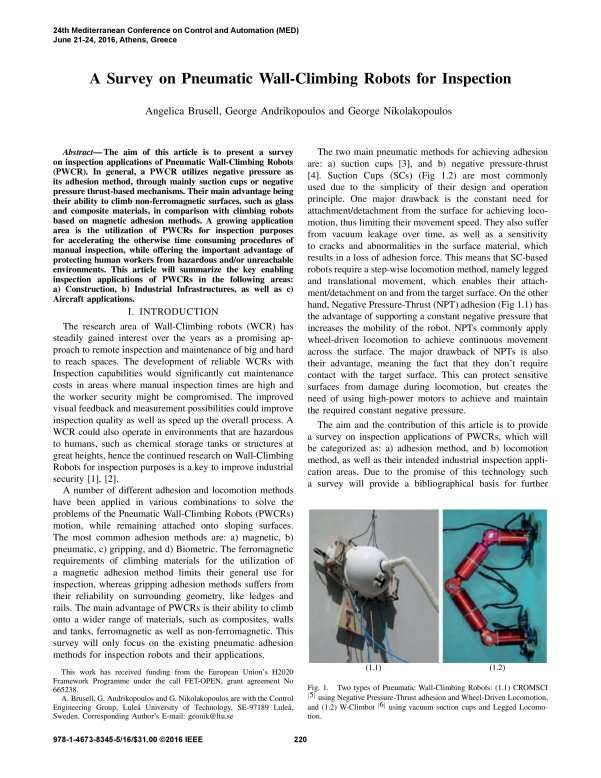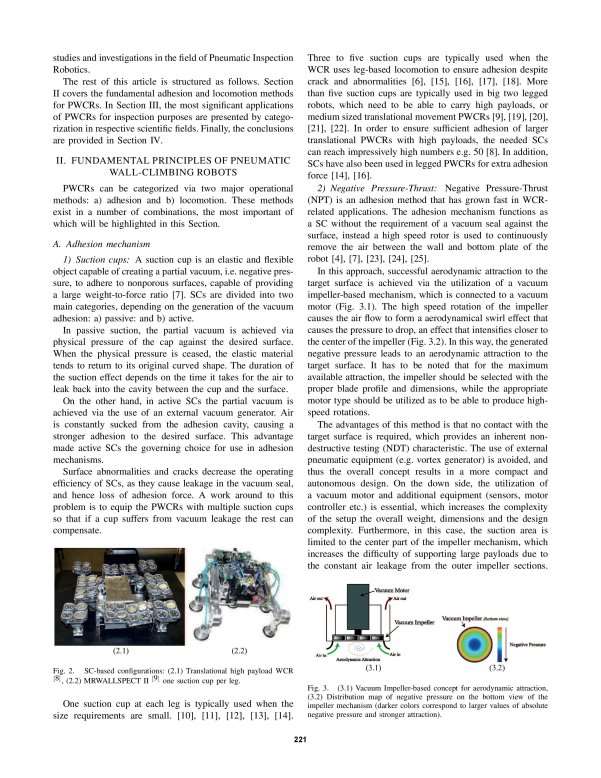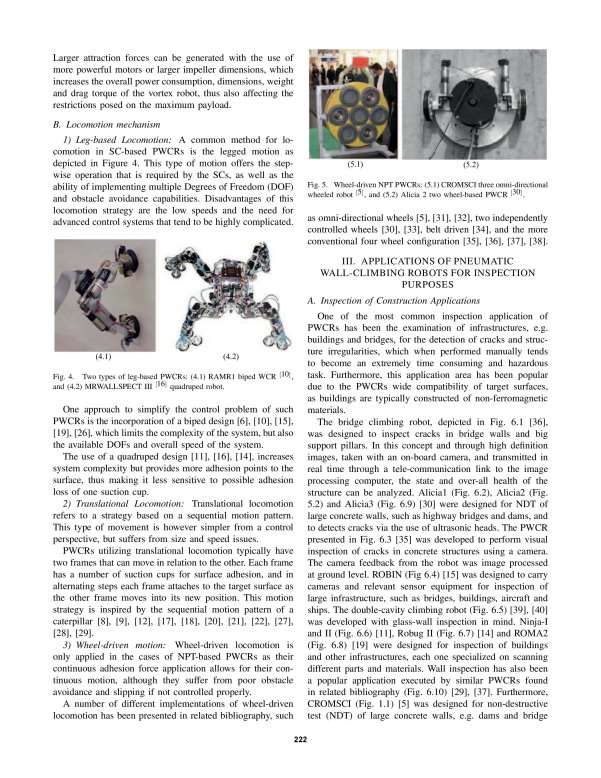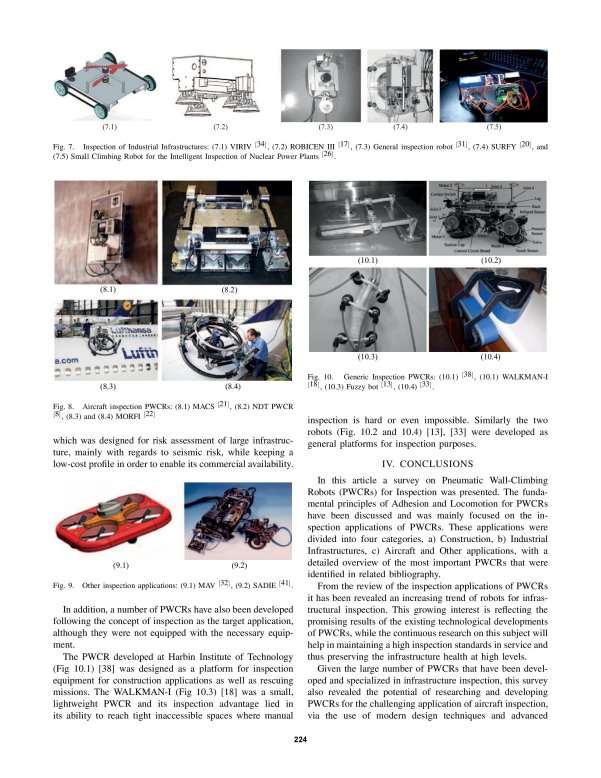Damage on Aerospace Composites and Metals Investigation
  This project is funded by the European Union
 This project is funded by the European Union
CompInnova
An Advanced Methodology for the Inspection and Quantification of Damage on Aerospace Composites and Metals using an Innovative Approach
WP8: Dissemination – Exploitation and Project Management
D8.11 Plan for Dissemination and Exploitation: 1st Report
Version 2
25 August 2016
|
Prepared by: |
EXIS Innovation, contribution from all partners |





History of changes
|
Version |
Date |
Status |
Page |
|
1 |
17.08.2016 |
The initial version of the document |
1 – 26 |
|
2 |
25.08.2016 |
Second version of the document |
1 – 37 |
|
3 |
21/03/2017 |
Revised according to the comments of the reviewers |






D8.11 Plan for Dissemination and Exploitation: 1st Report
|
Title |
An Advanced Methodology for the Inspection and Quantification of Damage on Aerospace Composites and Metals using an Innovative Approach |
|
Short Title |
CompInnova |
|
Project reference number |
665238 |
|
Project Sponsor |
H2020 FET-OPEN, European Commission |
|
Coordinating Principal Investigator/ Principal Investigator |
Prof. Len Gelman (Cranfield University – UK) |
|
Associate Investigator(s) |
EXIS Innovation LTD, Lulea Tekniska Universitet, the University of Ioannina and the University of Patras |
|
Location |
United Kingdom, Sweden, Greece |
© European Union, 2016
The information and views set out in this [report/study/article/publication…] are those of the author(s) and do not necessarily reflect the official opinion of the European Union. Neither the European Union institutions and bodies nor any person acting on their behalf may be held responsible for the use which may be made of the information contained therein.
No third-party textual or artistic material is included in the publication without the copyright holder’s prior consent to further dissemination by other third parties.
Reproduction is authorised provided the source is acknowledged.
Â
Table of Contents
List of figures
Â
Glossary of terms
|
Acronym |
Description |
|
D&E |
Dissemination and Exploitation |
|
EASA |
European Aviation Safety Agency |
|
FAA |
Federal Administration Aviation |
|
NDT |
Non Destructive Testing |
|
AROC |
Aircraft Related Operating Costs |
|
PA |
Phased Array |
|
IRT |
Infrared Thermography |
Â
This Dissemination and Exploitation plan has been prepared in accordance with the requirements of EU contract grant agreement 665238. Exis is the designated Dissemination and Exploitation (D&E) Manager of the project, appointed by the Consortium. The present report summarizes the actions that were taken in the first 12 months of the project. Continuously updated according to the project progress taking into account of the typical instruments will be incurred.
The use of lightweight materials with advanced properties, for reducing the flight cost and the maintenance cost has always been a research topic in aerospace. That can be understood by the rise in the use of composite materials throughout the years [1], 50% of the Boeing 787 Dreamline structure is made of composites, the percentage of composites materials of the new AIRBUS 350 XWB is 53% [2]. Consequently, new more efficient methods maintaining composites in aerospace are needed. Methods that will reduce the cost and maintenance time but without compromising in the safety of the passengers and the crew. Following the above, CompInnova project will provide a unique system that will combine two methods of inspection and an automated system for the repair of an aerospace structure. The main outcomes and novelties of the CompInnova project are:
- The development of a novel repairing system for the inspected damaged components.
- The development and functionality of the PA technique
- The development and functionality of IRT technique
- The development of a revolutionary automated multipurpose and multifunctional Vortex robot that it will carry for the first time integrate two inspection techniques and a repairing system.
- The development of novel Damage Tolerance algorithms for the Structural Health Assessment of the integrity of the aircraft
The concept to the CompInnova is presented in .

Figure 1. CompInnova Concept – Flow Chart.
Aim of this achievement is to drastically improve the quality of maintenance procedures and reduce significantly its time and cost. Eventually, such an approach is expected to bring multiple breakthroughs from the aircraft design level to maintenance, repair and certification standards.
Under this section, describes in details the dissemination efforts planned and completed by Consortium members during the first year. The aim of dissemination is to ensure that the partners are able to assimilate the results of the project and that non-confidential information about the CompInnova project reaches a wide and relevant audience to the best extent. All Consortium members are actively involved in carrying out dissemination activities and they are all contributing with their networks and contacts.
The work of the project is still under way and information related to Foreground is confidential. Especially at the early stages of a project, it is common and good practice to protect the Foreground Knowledge, therefore dissemination activities to the wider public, contain only limited technical information developed and planned during the first 12 months of the project. Taking under consideration the all the above the consortium has made several dissemination activities providing information about the concept of CompInnova, giving information’s about the early findings and developing relations with probable end users
1.1 Project Logo
Prior to any other activity, the Dissemination Manager proposed to create a logo to use in all correspondence activities and documents regarding CompInnova project. This logo can also act as the brand for any outcome/result of the project. EXIS Innovation developed different versions of the logo (), which circulated to the consortium for feedback and comments.

Figure 2. CompInnova different versions and final logo
The Consortium decided that the most suitable logo for the project purpose was the one named as final version in .
3.2 Project Web site
The project website was developed by EXIS Innovation (link: ) and it is continuously updated and maintained by EXIS with the help of the consortium members. The website gives an overview of the project, outlining the main objectives and has both a public and confidential area. The website is one of the promotion media used by the project partners to disseminate their involvement in the project.
The first version of the site developed during the first two months of the project and more information about is functionality can be found in 8.3 Deliverable 8.3 (Website and technical brochure development). In screenshots of the first version are presented.
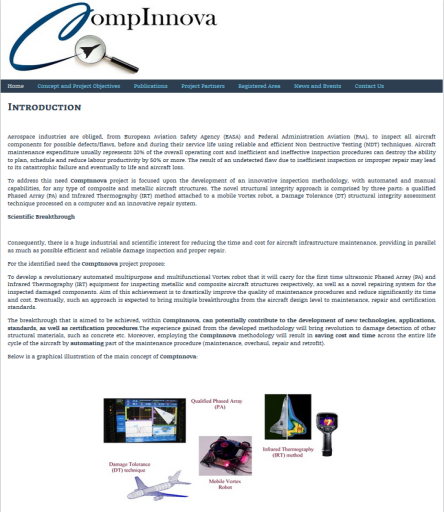
(a)
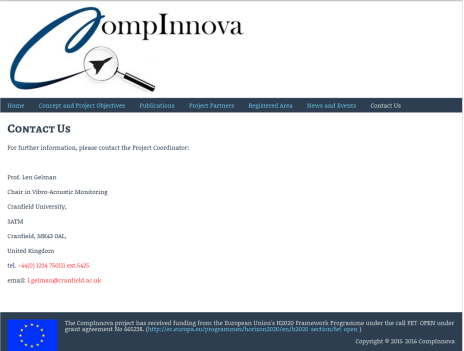
(b)
Figure 3. Screenshots of the first version of the web site (a) Home page, (b) Contact us
Because the website is a channel that a wide audience can access more easily, the consortium decided that not only has to be up-to-date but also to change during the project to reflect the ongoing research procedure. That is why the website is under continuous improvement, making it more attractive to any potential stakeholder, end user or investor. Therefore, in the second half of the first year of the project, EXIS improved the artistic side of the project by adding moving images, re-designed some pages to provide a better artistic and visual result for the visitor.
The updated version of the site consists of the following pages
- Introduction
- Concept and Project Objectives
- Publication
- Project Partners
- Registered Area
- News and Events
- Contact Us
Each page provides information about the project, the partners, the publications that will come out of the project and news and events related to the exploitation and dissemination activities of the consortium. There is also a page dedicated to the partners for sharing files and other material. Only the members of the consortium can access this page.

Figure 4. Home page of the improved CompInnova site
In the near future, it is planned to publicize more of the project activities and some of the technical work and results onto the website. It should be noted that the content of this would have to be reviewed and agreed by the entire consortium prior to any website updated.
The latest News and Events regarding conferences/exhibitions and meetings can be seen in . Under this section, the visitor can follow detailed articles about the respective meetings, illustrated with pictures taken on the spot. Confidential information on the meetings, such as the presentations or the meeting minutes, is only accessible for the consortium members in the confidential section on the ‘Registered Area’ page. Each consortium partner has its own login access data to the confidential ‘Documents’.
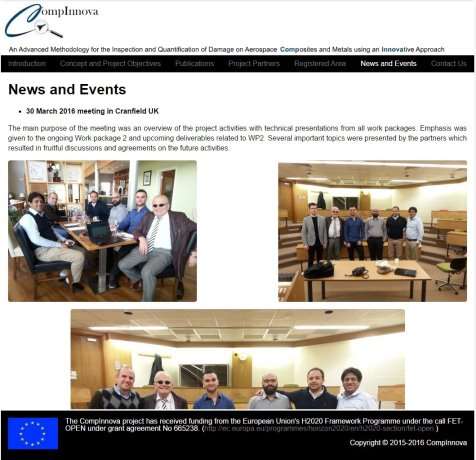
Figure 5. New and Events page

Figure 6. Concept and objectives page.
3.1 Web site of the partners
The partners for making CompInnova concept better known to a wider audience they have put a link and a small description of the project to their websites. In the following figures the web pages of the partners about CompInnova are presented.

Figure 7. CompInnova in EXIS website.

Figure 8. CompInnova in the web site of the UoI Lab

Figure 9. CompInnova in link in the UoP Laboratory web page

Figure 10. CompInnova on LTU web site
3.2  CompInnova Brochure
The Dissemination Manager in agreement with the rest of the consortium has decided to design a brochure, as this will be essential material for the dissemination of the project in conferences and exhibitions. This brochure will be updated each year to reflect the current state of the project and to contain the latest findings, in order to target better the audience of the CompInnova. This initial version can be seen in .

Figure 11. Initial version of the brochure in English
The mentioned brochure is divided into three parts. The first part contains both the project Logo and the European Commission / Horizon 2020 visual identity. Next part includes some general information about the CompInnova concept, the main targeted project objectives and the contact details of the coordinator. The logos of the Consortium members including the CompInnova acknowledge is also including in the last part of the brochure. More information about the project brochure was presented in more details in the previous deliverable 8.3 (Website and technical brochure development). The brochure is already translated in Greek, French, Swedish and during the second year will be translated to Spanish and Italian.

Figure 12. Greek Version of the CompInnova brochure

Figure 13. Initial version of the brochure in French

Figure 14. Brochure translated in Swedish
3.3 Publications, conferences and exhibitions
Even though the very early stage of the project, the Consortium managed to attend two exhibitions/conferences in the first 12 months of the project period. Generally, the partners that attend, introduced the concept of the project The actions are summarized in .
Table 1.List of Conferences and Exhibitions.
|
Partner |
Date |
Event |
|
UOP |
8-10 March 2016 |
JEC World Composite Show & Conference |
|
LTU |
21 -24 June 2016 |
Conference on Control and Automation (MED 2016) |
|
UoI |
20-24 March 2016 |
SPIE Smart Structures, NDE 2016 |
The Applied Mechanics Laboratory of the University of Patras (AML / UOP) was one of the exhibitors in JEC World 2016 [3]. The laboratory works in the field of materials and structures, including science, technology and applications of composite materials. Led by academics, highly trained engineers and PhD students, it offers a wide range of services in the composite materials sector. CompInnova was one of the projects that was presented at the laboratory’s stand area and a poster was designed for this reason. CompInnova’s tasks such as manufacturing, testing and repair of composite structures were presented and the collaboration with international known partners was highlighted. These gave us the chance to introduce CompInnova project to global market innovative solutions and tools and attract the interest of the show visitors (). Also the initial version of the brochure was modified to suit the needs of the world show ()


Figure 15. Photos from the UOP stand in the JEC World Composite Show & Conference 2016

Figure 16. CompInnova brochure for the JEC World Composite Show & Conference 2016
The article entitled “A survey on pneumatic wall-climbing robots for inspection”, was presented by LTU the 24th Mediterranean Conference on Control and Automation (MED 2016) [4], 21-24 June 2016, pp. 220-225, Athens, Greece (). Full article can be found in of the deliverable.

Figure 17. LTU, Conference Proceedings, “A Survey on Pneumatic Wall-Climbing Robots for Inspection”
University of Ioannina had presence in the SPIE Smart Structures/NDE 2016 which took place between 20 to 24 of March 2016 in Las Vegas USA [5], where the CompInnova brochure was handing out.
The objective of an Exploitation/Business Plan is to successfully manage to transition from prototype to production. Even though the early stage of the project, there are several promising results of the project. This will give the ability to the Consortium to design an even more aggressive approach to possible investors and industrial partners. The results once fully verified, can subject to publications or even patents. The project may deliver additional results by the end of the project that the partnership may wish to exploit. In this case, the Consortium (headed by the Exploitation Manager) will discuss use of such results on a case-by-case basis. Regarding the identification of IP, the Exploitation Manager, together with experts from the participating members of the Consortium, will be tasked with identifying any intellectual property that can be protected. When a protectable Foreground IP is discovered, the project coordinator will report it to the Exploitation Manager who will then assess its value and the best route for its protection and subsequent exploitation and/or dissemination.
4.1 The Market
Aircraft companies are increasingly using composites predominately in order to reduce weight and maintenance costs of the airplane. The use of composites in passenger has increased gradually from an average of 7% in 1980 to 25% by weight in the Airbus 380 [1] which entered the service at 2007; and by 50% by weight in the Boeing 787 Dreamliner [6] which entered commercial service in October 2011, with All Nippon Airways. The Airbus 350 XWB series () is the new wide body aircraft with 53% of carbon fiber composites usage by weight and an all composite fuselage, with 30 aircrafts in operation and 810 orders by July 2016 [7].

Figure 18. (a) Airbus A350 XWB Three-day demonstration at Farnborough Air show July 2016. (b) A350-1000 horizontal tail plane assembly February 2016 [8]
As the use of composites in aerospace is growing, it is more the obvious that the market is growing also. Boeing has invested this year more than $1 billion in its new 777X Composite wing center [9]. The facility will manufacture the world’s largest composite wing for the 777X, the company’s newest commercial jetliner.
With that growth of the use of composites, the need for systems that can inspect repair, more efficiently, in less time and reducing the cost is obvious. CompInnova idea comes to fill that need by the proposed novel automated inspect and repair system. Airbus is already interested in the findings of the project and expressed interest to contribute as an external evaluator/expert in the project.
4.1 Exploitation Strategy
4.1.1 Exploitation of results and activities is a dynamic procedure that will be updated and adjusted to the finding and achievements of the project. The overall exploitation strategy of the project will be based on the identification of the exploitable results, definition of the way that these results will be protected, sharing of the results and the means to do this and to identify possible industrial partners, stakeholders, investors. To enhance the exploitation strategy of the project the Consortium in the second year will create an Exploitation Management Group consisted from the Exploitation Manager and one member of each organization. The purpose of the group is to discuss in monthly basis the results and past and future activities and define the strategy based on the current state of the project. Exploitable results.
To identify the exploitable results a table was given to each partner to fill with these results (). The table contains the current results and results that may come during the project. Also, it has information about the current state of the results and the actions that where made towards obtaining them. Another element, that is crucial to understand how the results can be exploit is to categorize them. Categories can be products, software, services, process, this information is, also contained in the table. In addition, each partner will provide information about the group of people that these results may interest (Academic community, Aerospace industry etc.) This is needed to define the ways the results will be shared with the different groups, the levels of IP protection and the value proposition to each of the groups.
Table 2.Exploitable results
|
Partners |
Exploitable Result |
Category |
Target group |
Current state and actions |
|
LTU |
Small Scale Vortex Setup |
Experimental Setup, Method |
Aerospace industry Scientific Community |
|
|
LTU |
Small Scale Locomotion Setup |
Experimental Setup, Method |
Scientific Community |
|
|
LTU |
Vortex Robot Setup |
Experimental Setup, Product |
Aerospace industry Scientific Community |
|
|
LTU |
Dynamic Modelling and Control of the Vortex Robot |
Process, Method, System, Software |
Aerospace industry/Scientific Community |
|
|
UPAT |
Statistical optimization of laser-based material removal from CFRP structures for bonded repair purposes |
Process |
Scientific community Aerospace industry |
|
|
UPAT |
Statistical optimization of a chemical free laser-based metallic (Aluminium) pre-treatment for adhesive bonding and bonded repair purposes |
Process |
Scientific community |
|
|
Partners |
Exploitable Result |
Category |
Target group |
Current state and actions |
|
UPAT |
Bonding repair techniques (dry versus wet) performance assessment |
Procedure |
Scientific community |
|
|
UPAT |
Structural Health Monitoring of repaired structures. Fatigue damage Diagnostics and Prognostics with machine learning algorithms. |
Procedure/ Algorithms |
Scientific community, Aerospace industry, Composites industry |
|
|
UPAT |
Parameterized modelling of representative composite structures. Residual strength determination after impact. |
Procedure / Numerical model |
Scientific community, Aerospace industry |
|
4.2  Network with Industries
A network of Industries is gradually being established to ensure a wide spread of results outside of the Consortium. LinkedIn is the basic tool of this attempt. The D&E manager in cooperation with the rest of Consortium created the official LinkedIn page of the CompInnova project (). It is continuously updated and maintained in a weekly basis providing the latest news and technical outputs of the project. Exceptional mention was highlighted regarding the contribution of the European Union in the functionality and financing of the project.

Figure 19. CompInnova LinkedIn site
Each partner will actively engage their networks and contacts as part of these exploitation activities.
4.2.1 Potential End Users / Customers
The Dissemination Manager has already conducted a list with potential end users and investors and has started to contact them to discuss possible collaboration and to inform them about the concept of CompInnova
The list with the companies that may be interested in the project is presented in .
Table 3. List of potential end-users, investors
|
Organisation |
Address |
Website |
|
|
Cardiff Aviation |
Twin Peaks, Aerospace Business Park, St Athan, Vale of Glamorgan, CF62 4LZ |
||
|
AIRBUS |
France |
||
|
Aerospace Technology Institute |
UK |
||
|
ALTRAN |
UK |
||
|
British Airways Maintenance (BAMC) |
Cardiff Ltd PO Box 747, Cardiff international airport, CF62 3DN |
||
|
Flybe Aviation Services |
Hangar 2, Exeter Airport, Exeter, Devon, EX5 2BA |
||
|
Embraer |
Portugal |
||
|
Marshals Cambridge |
Cambridge, UK. |
||
|
Monarch Aircraft Engineering |
Hangar 60, Percival Way, London Luton Airport, Luton, LU2 9LX |
||
|
National Composites Centre (NCC) |
National Composites Centre |
||
|
SR Technics – MCC |
Zurich, Switzerland |
||
|
Snecma |
France |
||
|
Avotek Ltd |
UK |
||
|
BMI Regional Ltd |
UK |
As previous noted the consortium is in discussion with Airbus about the CompInnova project. Airbus, through our contact point, has showed a major interested for CompInnova concept and has asked to meet the consortium in person and discuss about the idea and to help with its experience in the field. The consortium is under the procedure to establish an industrial advisory board. For this reason, the consortium will make further contact with Airbus and with Cranfield Aerospace Solutions Ltd. The last expertize in the rapid system prototyping of new aerospace concepts and will help significantly towards the commercialization of the CompInnova system. In addition, the consortium will try to establish communications with the companies and organizations in the above list to have a third member in the board and to explore further strategic alliances. In addition, the consortium will investigate possible funding beyond the EU grant through the private sector. The consortium will discuss the further development of the technology or part of it with the members of the advisory board. In addition, as the projects matures and the first findings take a more solid form the consortium will consider organize a symposium where stakeholders will be invited to have a more insight look of the CompInnova project. Also partners will discuss further other possibilities to exploit the results through spin-off companies etc.
The IP of the results of the project and the background IP are regulated by the Consortium Agreement (CA) in sections 8 and 9. Especially for the obtain results of the projects the CA clearly states that the producer of the results is also the owner. Also, it provides details in the case the results are under joint ownership on how these results can be exploit by the joint partners and discuss in details the transfer of the IP of the results between partners. More details can be found in CA articles 8,9.
5.1 Patent Strategy
As most of the partners are universities one of their main goal it to try to publish in high impact journals or through conferences and exhibitions to attract possible industrial partners to fund further their research. Except these the consortium has discussed to explore the possibility of filing for patents. As these is a procedure that takes time and it is costly several things must be taken into consideration such as:
- Why to patent, what is the goal?
- The patent will be used offensively (revenue generation etc.)
- Or used defensively for marketing reason (to demonstrate innovation portfolio) or combination
- Which of the results are patentable?
- Are enough resources to maintain the patent?
The main reason to patent is to protect the intellectual property and maximize its value with respect to the intellectual property rights of others. . For companies creating value comes through increasing the revenues and for Universities by increasing their research funding and through technology dissemination.
Taking into consideration the above to pursue a patent protection for a result first it must be identified if it is patentable. To do that the involved partners with the help of the Exploitation manager must prepare a detail description of the result (invention disclosure) including the description of the methods, devices, parts and experiments if applicable. To make this procedure faster and more efficient a questionnaire is under preparation. This document is extremely valuable to evaluate if to file for a patent and to save time and money during the patent preparation and prosecution. In addition, this document will help to decide if the partners involved in the patent while file for a single patent of a group of patents involving the invention. Also, as previously stated the cost for filing and for the maintenance of the patent must be taken under consideration from the partners that are willing to file for patent.
As the procedure to file a patent is complex the Exploitation Management group will be in continuous communication between them, but also with the legal departments of the Universities (technology transfer offices) that usually handle the preparation and filing, how to license etc.
The Consortium members are organizing the dissemination & exploitation actions for the second stage (M12-M24) of the project life cycle. It will be more obvious to present the technical development and create solid publication on the project. In the below list the consortium has identified possible conferences that may participate, possible journals/magazines that may submit scientific papers/ articles and actions for the next year.
- Modelling and Control of a Vortex Suction Mechanism”, to be submitted in IEEE International Conference on Robotics and Automation (ICRA), June 3 2017, Singapore.
- “Optimal Control of an Impeller-based Actuation Method”, to be submitted in 20th World Congress of the International Federation of Automatic Control (IFAC), 9-14 July 2017, Toulouse, France.
- “On a Surface Tracking Robot based on Impeller Actuators”, to be submitted Elsevier’s Journal of Robotics, 2017.
- “COFREND Days”, Special 50th anniversary conference and exhibition of the French Society for NDT – Strasbourg (30-1 June 2017)
- “First World Congress on Condition Monitoring” – ILEC Conference Centre, London (13-16 June 2017).
- “14th International Conference on the Application of Contemporary NDT in Engineering” – Grand Hotel Bernardin, Bernardin, Slovenia (4-6 September 2017)
- Free project Webinar between the Consortium members and potential clients.
- Creation of the official CompInnova Google blog page.
- Update and maintenance of the official website and LinkedIn page.
LTU Conference Paper on MED 2016
